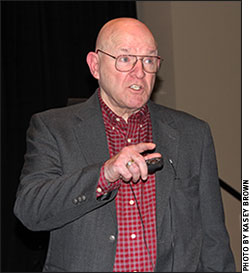Capturing Maximum Value
for the Beef Industry
Researcher shows how industry can improve on lost opportunities.
The relevance of lost opportunities in the beef industry amounted to $44 billion in 1989. Has the industry capitalized on regaining that value? That’s the question Texas A&M Visiting Professor Gary Smith sought to answer with attendees of the 25th Zoetis-sponsored Cattlemen’s College® during the 2018 Cattle Industry Convention in Phoenix, Ariz., Jan. 31-Feb. 2.
In conjunction with the National Beef Quality Audit (NBQA) in 1991, National Cattlemen’s Association Chief Economist Chuck Lambert presented “Lost Opportunities in Beef Production.” The study revealed there were billions of dollars of annual potential gain that the beef industry was missing. Eleven areas were identified for improvement: reproductive performance, death loss, hot-iron branding, weaning weight, multiple processing, feed efficiency, outlier cattle, excess fat, management, retail shrink, and out-of-stocks. Smith highlighted four key areas: reproductive performance, calf death, excess fat and retail issues.
On reproductive performance, Lambert reported the industry was sitting at 80% success in 1991, meaning the industry was losing out on about $2.6 billion compared to if it were at a 95% reproductive success rate. Smith said a current panel of experts evaluated the industry today, estimating reproductive success at about 85% today, noting the industry has improved.
Lambert reported that 86.5% of cows had a calf, but between birth and the packinghouse, 6.5% of calves died for various reasons. The economic loss was estimated at $1.86 billion. This loss was predicated on $1.73 billion for keeping females that did not wean a calf, and $0.13 billion in feed and management costs for the live calves that died before slaughter, Smith explained. However, the expert panel said there has been little to no improvement in death loss since then, despite the improvement in reproductive performance.

Gary Smith noted research that showed feeding vitamin E at the feedyard improves color of retail meat and increases shelf life by three days. Unfortunately, there hasn’t been enough of a market signal to warrant the admittedly low cost of feeding the vitamin E, he said.
Excess fat of more than 0.25 inches (in.) was estimated in 1991 to cost $4.41 billion due to excessive feed costs ($2 billion), trimming ($1.99 billion) and rendering ($0.42 billion).
Smith said excess fat is now unusable by many grocery stores. The government requires them to keep grinding logs, and many don’t want the increased hassle. Thus, many grocery stores that used to use the trim in ground beef no longer do. The trim now has to go to rendering instead of being used.
Smith urged, “Get rid of the waste fat, but keep the taste fat (intramuscular fat).”
Retail issues were retail shrink and out-of-stocks. Lambert reported that retail shrink — lost revenue from markdowns and price differentials on reworks — averaged 6% of total supermarket meatcase beef sales. This results in a loss of $0.852 billion per year.
The expert panel said 4.8% gets marked down and sold, but 5.2% gets thrown away.
Smith noted research that showed feeding vitamin E at the feedyard improves color of retail meat and increases shelf life by three days. Unfortunately, there hasn’t been enough of a market signal to warrant the admittedly low cost of feeding the vitamin E, he said.
Additionally, out-of-stocks — meaning an empty shelf — occurs about 16% of the time, he said, costing $0.916 billion. He noted that centralized cutting could help alleviate this issue.
As a whole, he said the panel of experts concluded that the industry has regained about 5% of the lost opportunities, but there is still work to be done.
He concluded that in 2016, total gross revenues from beef sales and fed-cattle byproducts were $103 billion. The total cost of these beef industry inefficiencies amounts to $939 per fed steer or heifer. The beef industry could increase gross revenues by 22% if existing lost opportunities were corrected.

Editor’s Note: This article was written as part of Angus Media’s coverage of the 2018 Cattle Industry Convention in Phoenix, Ariz.






